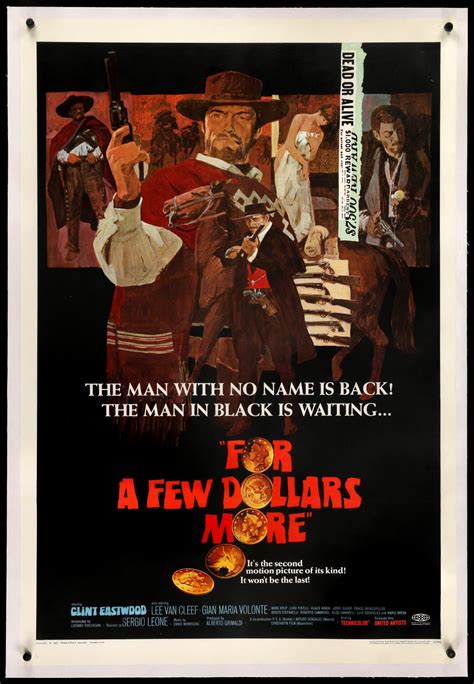For a Few Dollars More

Description:
For a Few Dollars More is a 1965 spaghetti Western film directed by Sergio Leone. It follows two bounty hunters, played by Clint Eastwood and Lee Van Cleef, as they team up to capture a notorious outlaw. The film is known for its iconic characters, tense atmosphere, and unforgettable score by Ennio Morricone.Keywords:
Bounty, Revenge, Showdown, Outlaws, Morricone, GunslingerHow much did Clint Eastwood get paid For a Few Dollars More?
Clint Eastwood was paid approximately $250,000 for his role in "For a Few Dollars More," which was released in 1965. This film was the second installment of Sergio Leone's "Dollars Trilogy," following "A Fistful of Dollars." Eastwood's performance solidified his status as a leading figure in the spaghetti western genre, contributing to his rising fame during that era. The film was both a commercial success and a critical favorite, further establishing the collaboration between Eastwood and Leone.
What is the significance of the watch in For a Few Dollars More?
In "For a Few Dollars More," the watch symbolizes time, fate, and revenge. The character Colonel Douglas Mortimer uses a unique pocket watch that not only tracks time but also serves as a personal memento of his past, particularly the loss of his sister to the gang led by Indio. The watch's mechanism, which he uses to time his gunfight, highlights the tension between life and death, emphasizing that time is both a precious resource and a tool for vengeance. Ultimately, it represents Mortimer's quest for justice and closure.
Where in Spain was a few dollars more filmed?
"For a Few Dollars More," directed by Sergio Leone, was primarily filmed in Spain, particularly in the Tabernas Desert in Almería. This desert region provided the arid landscapes typical of the American Wild West. Additional filming locations included the towns of Almería and the Spanish locations of the Sierra de Almijara and the town of El Paso. These sites contributed to the film's iconic visuals and helped establish the Spaghetti Western genre.
Why is For a Few Dollars More rated R?
"For a Few Dollars More" is rated R primarily for its violence, which includes gunfights and graphic depictions of death, typical of the Spaghetti Western genre. The film also contains some strong language and mature themes, including revenge and betrayal. While it may not be excessively graphic by modern standards, the portrayal of violence and adult situations contributed to its R rating, reflecting the filmmakers' intention to create a gritty and realistic atmosphere.
Explore More Categories: